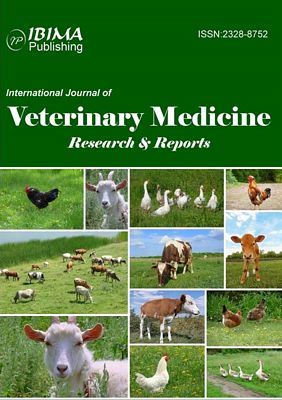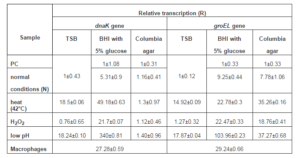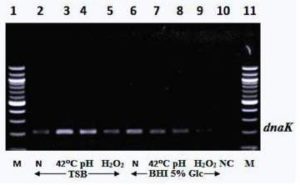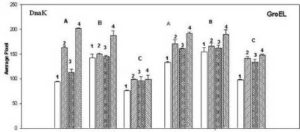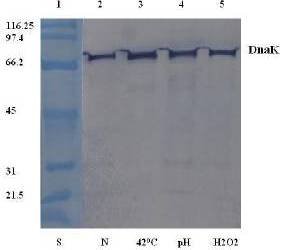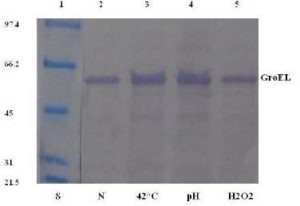Al Dahouk, S., Scholz, H. C., Tomaso, H., Bahn, P., Göllner, C., Karges, W., Appel, B., Hensel, A., Neubauer, H. & Nöckler, K. (2010). “Differential Phenotyping of Brucella Species Using a Newly Developed Semi-Automated Metabolic System,” BMC Microbiology, 10, 269.
Publisher – Google Scholar
Alton, G. G., Jones, L. M., Angus, R. D. & Verger, J. M. (1988). Techniques for the Brucellosis Laboratory, Paris, Institut National de la Recherche Agronomique.
Publisher – Google Scholar
Bianchi, A. A. & Baneyx, F. (1999). “Hyperosmotic Shock Induces the  32 and
32 and  E Stress Regulons of Escherichia Coli,”Molecular Microbiology, 34(5), 1029-1038.
E Stress Regulons of Escherichia Coli,”Molecular Microbiology, 34(5), 1029-1038.
Publisher – Google Scholar
Buchmeier, N. A., & Heffron, F. (1990). “Induction of Salmonella Stress Proteins upon Infection of Macrophages,”Science, 248(4956), 730-732.
Publisher – Google Scholar
Cardoso, K., Gandra, R. F., Wisniewski, E. S., Osaku, C. A., Kadowaki, M. K., Felipach-Neto, V., Haus, L. F., & Simão, R. de C. (2010). “DnaK and GroEL are Induced in Response to Antibiotic and Heat Shock in Acinetobacter Baumannii,”Journal of Medical Microbiology, 59(P” 9), 1061-1068.
Publisher – Google Scholar
Cellier, M. F., Teyssier, J., Nicolas, M., Liautard, J. P., Marti, J. & Sri Widada, J. (1992). “Cloning and Characterization of the Brucella Ovis Heat Shock Protein DnaK Functionally Expressed in Escherichia Coli,” Journal of Bacteriology, 174, 8036-8042.
Publisher – Google Scholar
Celli, J. (2006). “Surviving inside a Macrophage: The Many Ways of Brucella,” Research Microbiology, 157, 93-98.
Publisher – Google Scholar
Chuang, S. E. & Blattner, F. R. (1993). “Characterization of Twenty-Six New Heat Shock Genes of Escherichia Coli,”Journal of Bacteriology, 175(16), 5242-5252.
Publisher – Google Scholar
Enright, F. M. (1990). ‘The Pathogenesis and Pathobiology of Brucella Infection in Domestic Animals,’ In Animal Brucellosis, Eds. Nielsen, K. and Duncan, J. R. CRC Press, Inc., Boca Raton, Fla., PP. 301-320.
Google Scholar
Foster, J. W. (1991). “Salmonella Acid Shock Proteins are Required for the Adaptive Acid Tolerance Response,” Journal of Bacteriology, 173(21), 6896-6902.
Publisher – Google Scholar
Guerra, H. (2007). “The Brucellae and their Success as Pathogens,” Critical Reviews in Microbiology, 33, 325-331.
Publisher – Google Scholar
Hendrick, J. P. & Hartl, F.- U. (1993). “Molecular Chaperone Functions of Heat-Shock Proteins,” Annual Review of Biochemistry, 62, 349-384.
Publisher – Google Scholar
Köhler, S., Ekaza, E., Paquet, J.- Y., Walravens, K., Teyssier, J., Godfroid, J. & Liautard, J.- P. (2002). “Induction ofdnaK through its Native Heat Shock Promotor is Necessary for Intramacrophagic Replication of Brucella Suis,” Infection and Immunity, 70(3), 1631-1634.
Publisher – Google Scholar
Köhler, S., Porte, F., Jubier-Maurin, V., Ouahrani-Bettache, S., Teyssier, J. & Liautard, J. P. (2002). “The Intramacrophagic Environment of Brucella Suis and Bacterial Response,” Veterinary Microbiology, 90(1-4) 299-309.
Publisher – Google Scholar
Köhler, S., Teyssier, J., Cloeckaert, A., Rouot, B. & Liautard, J. P. (1996). “Participation of the Molecular Chaperone DnaK Intracellular Growth of Brucella Suis within U937-Derived Phagocytes,” Molecular Microbiology, 20(4), 701-712.
Publisher – Google Scholar
Lin , J., Adams L. G. & Ficht T. A. (1992). “Characterization of the Heat Shock Response in Brucella Abortus and Isolation of the Genes Encoding the GroEL Heat Shock Proteins,” Infection and Immunity, 60(6), 2425-2431.
Publisher
Lin, J. & Ficht, T. A. (1995a). “Protein Synthesis in Brucella Abortus Induced during Macrophage Infection,” Infection and Immunity, 63(4), 1409-1414.
Publisher
Lin, J., Lee, I. S., Frey, J., Slonczewski, J. L. & Foster, J. W. (1995b). “Comparative Analysis of Extreme Acid Survival in Salmonella Typhimurium, Shigella Flexneri, and Escherichia Coli,” Journal of Bacteriology, 177(14), 4097-4104.
Publisher – Google Scholar
McAlpin, J. G. & Slanetz, C. A. (1928). “Studies on the Metabolism of Abortusmelitensis Group 3. Glucose Utilization,“Journal of Infectious Diseases, 42(1), 73-78.
Publisher – Google Scholar
Meury, J. & Kohiyama, M. (1991). “Role of Heat Shock Protein DnaK in Osmotic Adaptation of Escherichia Coli,” Journal of Bacteriology, 173(14), 4404—4410.
Publisher – Google Scholar
Meyer, M. E. (1969). “Brucella Organisms Isolated from Dogs: Comparison of Characteristics of Members of the Genus Brucella,” American Journal of Veterinary Research, 30, 1751-1756.
Publisher – Google Scholar
Prasad, J., McJarrow, P. & Gopal, P. (2003). “Heat and Osmotic Stress Responses of Probiotic Lactobacillus Rhamnosus HN001 (DR20) in Relation to Viability after Drying,” Applied Environmental Microbiology, 69(2), 917-925.
Publisher – Google Scholar
Rafie-Kolpin, M., Essenberg, R. C. & Wyckoff III, J. H. (1996). “Identification and Comparison of Macrophage-Induced Proteins and Proteins Induced under Various Stress Conditions in Brucella Abortus,” Infection and Immunity, 64(12), 5274-5283.
Publisher – Google Scholar
Roop, R. M. 2nd, Gaines, J. M., Anderson, E. S., Caswell, C. C. & Martin, D. W. (2009). “Survival of the Fittest: HowBrucella Strains Adapt to their Intracellular Niche in the Host,” Medical Microbiology and Immunology, 198(4), 221-238.
Publisher – Google Scholar
Salisbury, S. (1997). ‘Genotypic Detection of Methicillin-Resistant Staphylococci by Multiplex PCR Assay,’ LabMedicaInternational, 16-7.
Smith, III, R. (1990). ‘T lymphocyte-Mediated Mechanisms of Acquired Protective Immunity against Brucellosis in Cattle,’ In Advances in brucellosis research, Eds. C Adams, L. G. College Station: Texas A&M University Press, PP. 164-190.
Google Scholar
Susin, M. F., Baldini, R. L., Gueiros-Filho, F. & Gomes, S. L. (2006). “GroES/GroEL and DnaK/DnaJ Have Distinct Roles in Stress Responses and during Cell Cycle Progression in Caulobacter Crescentus,” Journal of Bacteriology, 188(23), 8044-8053.
Publisher – Google Scholar
Teixeira-Gomes, A. P., Cloeckaert, A., Bezard, G., Bowden, R. A., Dubray, G. & Zygmunt, M. S. (1997). “Identification and Characterization of Brucella Ovis Immunogenic Proteins Using Two-Dimensional Electrophoresis and Immunoblotting,” Electrophoresis, 18, 1491-1497.
Publisher – Google Scholar
Teixeira-Gomes, A. P., Cloeckaert, A. & Zygmunt, M. S. (2000). “Characterization of Heat, Oxidative, and Acidic Stress Responses in Brucella Melitensis,” Infection and Immunity, 68(5), 2954-2961.
Publisher – Google Scholar
Tsolis, R. M., Seshadri, R., Santos, R. L., Sangari, F. J., Lobo, J. M., de Jong, M. F., Ren, Q., Myers, G., Brinkac, L. M., Nelson, W. C., Deboy, R. T., Angiuoli, S., Khouri, H., Dimitrov, G., Robinson, J. R., Mulligan, S., Walker, R. L., Elzer, P. E., Hassan, K. A. & Paulsen, I. T. (2009). “Genome Degradation in Brucella Ovis Corresponds with Narrowing of its Host Range and Tissue Tropism,” PloS ONE, 4(5): e5519.
Publisher – Google Scholar
von Bargen, K., Gorvel, J. P. & Salcedo, S. P. (2012). “Internal Affairs: Investigating the Brucella Intracellular Lifestyle,”FEMS Microbiology Reviews, 36, 533-562.
Publisher – Google Scholar
Young, E. J. (2009). ‘Brucellosis. In Mandell, Douglas and Bennett’s Principles and Practice of Infectious Disease,’ 7th edn., Eds. Mandell, G.L., Bennett, J.E., and Dolin, R., Churchill Livingstone.
Yushan, H., Lei, L., Weijia., L. & Xiaoguang, C. (2010). “Sequence Analysis of the groEL Gene and its Potential Application in Identification of Pathogenic Bacteria,” African Journal of Microbiology Research, 4(16), 1733-1741.
Publisher – Google Scholar
Zobell, C. E. & Meyer, K. F. (1930). “Metabolism Studies on the Brucella Group II. The Fermentation of Monosaccharides,” Experimental Biology and Medicine, 28(2), 160-162.
Publisher – Google Scholar



